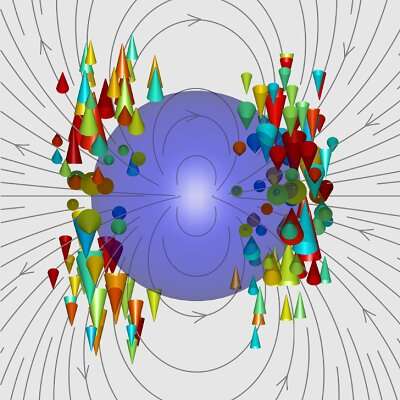Spin structure (thick arrows) around a spherical nanosized hole or pore (in blue) in a magnetic matrix (in light grey). Magnetic SANS can detect and analyse such structures. Credit: University of Luxembourg
Professor Andreas Michels, physicist at the University of Luxembourg, explores the complex world of magnetic materials by shooting neutrons on them. He has now published his insights in a 380-page monograph titled "Magnetic Small-Angle Neutron Scattering − A Probe for Mesoscale Magnetism Analysis." The book is published by Oxford University Press.
Being the result of more than two decades of experimental, theoretical, and simulation research, Prof. Andreas Michels has now written the first book dedicated exclusively to the specific neutron technique of magnetic small-angle neutron scattering (SANS). "Whenever you want to know where magnetic atoms are located in a material and how they move, you have to use neutron scattering," says Prof. Andreas Michels. The neutron is an elementary particle which carries a magnetic moment or spin. As such, one can think of the neutron as a tiny compass needle, which, when deflected or scattered by a magnet, yields information on the structure and dynamics of the atoms composing the material. The quantity of interest in a neutron-scattering experiment, the so-called scattering cross section, depends on the distribution of spins of the studied material and its analysis provides important information on the magnetic properties.
Prof. Michels continues "The magnetic SANS method is indispensable in the study of magnetic materials; one can use it to investigate everything from permanent magnets, magnetic steels, complex oxides and alloys, ferrofluids, magnetic nanoparticles, to superconductors and the recently discovered skyrmion crystals." The reason for its importance in condensed-matter and materials physics resides in the fact that magnetic SANS provides, quite uniquely, access to the so-called mesoscopic length scale, i.e., the scale between a few nanometers and a few hundred of nanometers—roughly between the size of a strand of human DNA to about one hundredth of the width of a human hair. This is a very important size regime on which many macroscopic material properties are realised. The SANS method is particularly useful for materials scientists to help them understand the magnets they produce in their labs.
"For example, one can use the magnetic SANS technique to decide whether a particular material is composed of homogeneous or inhomogeneous magnetic domains; these are regions inside the magnet where the spins point into a certain direction," explains Prof. Michels. This question is of relevance for improving the characteristic parameters such as the coercivity or the maximum energy product of rare-earth-free permanent magnets, a class of magnetic energy materials which is currently in the focus of many researchers worldwide. Another example relates to the mechanical properties of steel, which is probably one of the oldest and most important functional magnetic materials. The mechanical hardness of reactor pressure vessel steel, used in nuclear power plants, is decisively determined by the presence of voids (pores). The figure below depicts the numerically computed spin structure around a spherical nanopore; the formalism of the book allows one to detect their signature in the neutron scattering cross section.
The book has emerged by "marrying" two relatively old fields in physics—the theory of micromagnetics on the one hand side and neutron-scattering formalism on the other hand side. Micromagnetics is commonly used to analyze the magnetization distribution or hysteresis loop of magnetic materials, while neutron scattering is employed to obtain microscopic information on the structure and dynamics of materials. "Before, micromagnetics and neutron scattering were two disjunct communities who did not talk much to each other," adds Michels. With the publication of the book, and through the organization of international workshops such as the one at the European Spallation Source in Lund, it is hoped that the combined micromagnetics & SANS methodology is becoming more widespread, so that research on magnetic materials can further progress.
Looking forward, what are the challenges for the years to come? Clearly, much research needs to be carried out on so-called complex systems, which are materials exhibiting a multitude of interactions on different length scales; examples are ferrofluids, magnetic steels, spin glasses or amorphous magnets. It is this subfield where major progress is expected to be made in the coming years; mainly via the increased usage of large-scale numerical micromagnetic simulations, which is a very promising approach for the understanding of the magnetic SANS from systems exhibiting nanoscale spin inhomogeneity.
The book's target audience consists of graduate students as well as postdocs and senior researchers working in the field of magnetism and magnetic materials. The formalism and concepts that are laid out in the book will hopefully enable them to analyze and interpret their SANS experiments." explains Professor Andreas Michels. "It took me about three years to write the book, and I am now more than happy to see its publication," says Michels. The monograph is available as a hardcover edition and as e-book, and can be ordered in bookstores around the world.
More information: Magnetic Small-Angle Neutron Scattering − A Probe for Mesoscale Magnetism Analysis
Provided by University of Luxembourg
























